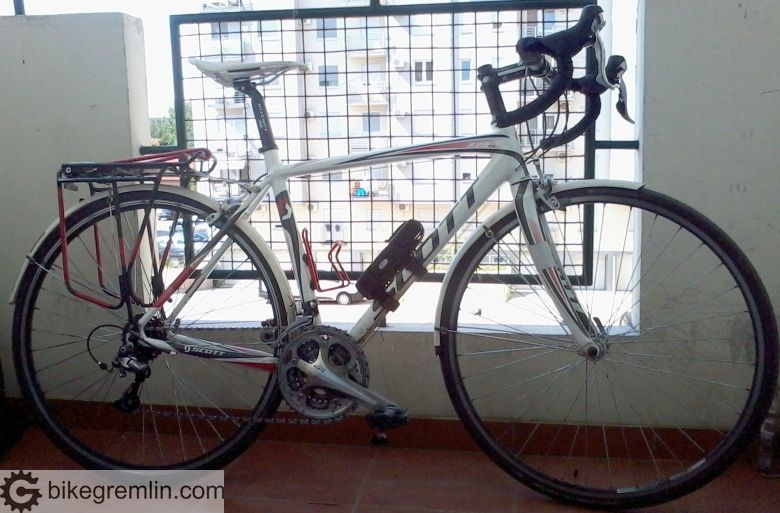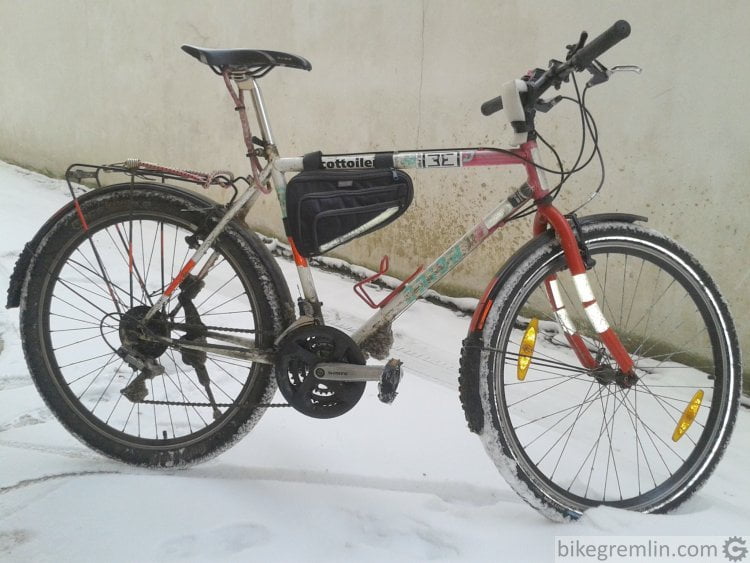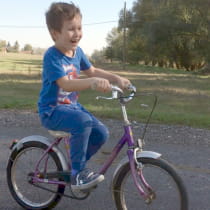In this post I’ll write about things important for using a bicycle as a means of transport. Whether it is commuting to work, going to school, training, theatre etc. Starting from what kind of bicycle is best for this use, over clothing, and practice (i.e. what has worked best for me). In a separate post I discussed transporting children by a bicycle.
Table Of Contents (T.O.C.):
- Introduction
- Pros and cons of bicycle commuting
- What kind of bicycle is the best for commuting?
- How to dress for bicycle commuting?
4.1. Women’s clothes & makeup, and bicycle commuting
4.2. Helmets for bicycle commuting - Other things to consider
- Bicycle commuting in the rain?
- Bicycle commuting in the winter (snow, ice, freezing)
- Traffic – is it dangerous?
- Conclusion and useful sources
1. Introduction
“Technical” part:
Bicycle commuting is a complex topic. I mean: it’s simple to understand, but it incorporates cyclist traffic safety, locks and safely locking a bicycle, choosing practical clothing for cycling (especially if it’s rainy, or cold) etc.
That is why, in order to make this post shorter, I’ll add links to posts that explain these connected topics. I recommend you first read this post entirely, then, if you need more information, star over, clicking on links to posts that explain topics of interest in more details. Like the ones linked in the paragraph above.
Note: I’ve put a lot of (hopefully useful) information in this post. Don’t let that scare you. Just start bicycle commuting, and use this as a reference, when you need some advice, or help. Bicycle commuting is cool, easy, convenient and you will quickly get the hang of it and most probably like it.
Personal part:
I love cycling, which goes for commuting to work, going to the gym, and most other places. Of course, not all the people are the same (i.e. that crazy 🙂 ), some don’t enjoy cycling as much. The main aim of this post is to bring bicycle commuting closer to everyone, offering useful tips and advice. Helping people give it a try and see how often and on which occasions it suits them.
2. Pros and cons of bicycle commuting
Bicycle commuting has its good, and its bad sides. I’ll list them here. Do note that the number of pros and cons is not important – it’s the “weight” of each, i.e. how much does something bother you in particular (depending on your circumstances, city/village, traffic etc).
Downsides of bicycle commuting:
- You are exposed to the weather (though this also builds the character, while good clothes help a lot).
- It takes more time to cover greater distances (over 10-6 miles in urban, traffic jam environments, and over 2 miles in rural areas), and it’s less convenient going up hills (electric bicycles help with this).
- You are more difficult to spot in traffic, while in case of an accident, there’s no steel cage to protect you (like there is in a car). You have to think and plan ahead – how to avoid typical cycling traffic accidents.
- With a car you can transport more people and more luggage. Pets (animals) who are not used to bicycle transport will not sit still in a bicycle trailer, or a basket.
- In my city at least, bicycle thefts are a lot more common than car thefts (wrote about a solution in chapter 5 of the post about safe bicycle overtaking distance).
- You can fall off a bicycle – it needs active balance.
Advantages of bicycle commuting:
- It is healthy and meditative. It’s a good recreation and a lot more relaxed than driving – especially if there are traffic jams. You usually reach the destination smiling and feeling fully awake (for the morning commutes).
- If there are traffic jams, bicycle commuting can often be faster than using a car, or public transport.
- For the most part there are no worries about speeding, parking tickets and similar problems.
- It’s cheaper – saves money compared to car, or even public transport costs.
- More eco-friendly, compared to car transport.
- You are increasing the number of cyclists, so drivers can get used to them being on the roads, thus increasing cyclists traffic safety.
- Decreasing traffic jams (why cars are not sustainable).
- It’s more fun than driving a car – especially if there are traffic jams.
- Makes you a better driver – by learning and practising to note other cyclists, “read” what (careless) drivers will do (in advance) etc.
- You can find and use any shortcut, since you practically can go with a bicycle anywhere where you can go on foot. Carrying bicycle briefly in your hands when/if needed. You will feel even the slightest inclines/downslopes, learn the road quality of every section…
- I would also add that if you give a girl/woman a lift on a bicycle, it can be a lot more romantic than using a car. Not sure if it’s the same for women – since men are usually taller and heavier – and, at least in my experience, a lot less courageous when being driven on a bicycle, or motorcycle (if a passenger is scared, and not enjoying the ride, even when you are going slowly and carefully, it’s best to just stop).
In my opinion and experience, practically all the downsides can be “eliminated” with some common sense, caution and practice – but it is only fair to note them. When cycling, I almost always feel like the kid from the cover picture of this post. 🙂
3. What kind of bicycle is the best for commuting?
After this article was published, I wrote a separate Commuting bicycle buying guide.
What has worked very well for me:
Bicycles that can mount full sized mudguards (usually those are bicycles without suspension – pros and cons of bicycle suspension). Without mudguards, even if it’s not raining, and you just ride through a puddle, or ride on wet pavement, you will most likely have to change dirty clothes when you reach your destination.
It is very practical if a luggage rack can be mounted on a commuting bicycle. Sure, you can use a backpack for any stuff, and/or spare clothes, but it’s a lot more comfortable (and cooler in the summer) if that is placed on a bicycle rack, not on your back. For more details on this see: how to mount backpack and panniers on a bicycle.
For longer distances (over 10 miles), it is handy if a bicycle has drop bars (like on road/racing bicycles), though that’s not necessary (also boils down to personal taste). The advantage of drop bars are several different hand positions and the option of taking a more aerodynamic riding position.
Flat bars, on the other hand, are more convenient for city rush traffic, and if parking bicycles in crowded locking places (flat bars don’t get as easily entangled with other bicycles on a rack). Flat bars are also a bit more practical if some luggage is hauled in one hand, or on the handlebars.
Disc brakes can be a problem in crowded urban bicycle parking spaces, since brake discs (“rotors” as often wrongly referred to in cycling jargon) can be easily bent by other bicycles leaned against them. Pros and cons of bicycle disc brakes (compared to rim brakes).
Bicycle’s quality should be decent. Nothing fancy, but it should have decently working brakes, shifters, lights, no mechanical malfunctions – so you don’t waste time on those problems and perhaps come in late because of them.
If you have some (steep) climbs, it would be good if bicycle has some gears – preferably 2, or 3 chainrings at the front, and 6 to 8 (or more if one prefers) at the back. How many gears is best for a bicycle?
Finally, it is preferable for the bicycle to be as ugly and as cheap looking as possible – to not attract many thieves.
A few examples:

Picture 1
Bicycle in picture 1 is good for longer distances, but it has no room for wider studded winter tyres (for cycling in the snow/ice), and it looks too nice for it to be safe when locked on a parking. Of course, not everyone plans to ride in the snow/winter, but those who do, should plan for it.

Picture 2
Bicycle in picture 2 is a good alternative. It looks a bit less flashy/eye-catching, while it is quite convenient for bicycle commuting: full sized mudguards, rack (with pannier mounts), and enough room within the frame (and below the mudguards) for mounting wider tyres for winter cycling.

Picture 3
Bicycle in picture 3 is a great example of a budget solution. It is robust, can take wider tyres, and accepts mudguards and rack. It looks rather ugly, which is perfect for a commuting bicycle. Finally, one advantage of 26″ wheels is that they are a bit smaller – making the bike’s overall length shorter, hence more convenient for getting into elevators, tight stairwells etc.
In a separate post I wrote about what kind of bicycle is good for winter (and snow/ice).
For those wearing skirts/dresses:

Great Scotland supporters in Novi Sad are clearing the pitch from snow, so a match can be played (because us lazy-bags didn’t lift a finger) – cheers mates, come back anytime! 🙂
Picture 4
“Women’s” bicycles, that have no high horizontal top-tube on their frames (step through frames) can be more convenient.

Picture 5

Picture 6
4. How to dress for bicycle commuting?
First the painful truth that many “serious” cyclists won’t easily admit: you don’t need any special clothes for cycling. Period.
I cycle to work in jeans and a shirt, with a jacket on top if it’s really cold, and/or a poncho rain coat if the rain is really pouring.
Of course, if you travel for over 8 miles, or have some steep climbs, you could get sweaty, especially in the summer, so it’s good to take just some shorts and a shirt, then put on a change of clothes upon arrival. But for the most part, “civilian” clothes are generally OK.
So don’t fall for any marketing hype and first give it a go and see which of the clothes that you already have are good for bicycle commuting. This is not a high intensity training ride (it can be if you like, on the way back for example, then taking a shower at home 🙂 ). Even if you wish to ride in a more sport-like manner, changing clothes upon arrival, I would say: any clothes good enough for running (or mountain hiking) are quite good for cycling. You don’t have to buy bicycle specific clothing right away.
It helps if you dress in layers, so you can remove any extra clothes (and pack them in a backpack), so you don’t sweat too much. It’s generally better to feel a bit cold when you start cycling, because the body will warm up really quickly and if you start “comfortably” dressed, you will be too hot in no time. I wrote in more details on this in the post about how to dress for (winter) cycling? Put briefly: you’ll figure out what works for you, in various types of weather. It is individual and takes a bit of trial and error.
This is a nice excuse for bicycle equipment and clothes shopping, but I would recommend you start from the clothes you have at hand, give it a go, and see what works best for you – before going shopping.
Ankle straps (Amazon affiliate link), preferably reflective, for trousers are a must, unless your bicycle has a full sized chainguard.

Picture 7
I already wrote about cycling sunglasses. They are not critical, though I almost always wear them – for wind (in the winter) and insects (in the summer).
4.1. Women’s clothes & makeup, and bicycle commuting
OK, I very rarely wear a dress and makeup (Haloween doesn’t count). 🙂 So I had to ask female friends for advice – and here’s what they have to say (I’ll be using the term “skirt” for both skirts and dresses, where difference is not crucial). Of course, this is all Greek to me, so if they say to put some mustard behind the ears, just for laughs, I’ll re-post that here as well. 🙂
Avoid materials that are easily crumpled, like satin.
Tights, or shorter version of those (i.e. “cycling” shorts) is good to wear under a skirt, especially if it is short and fluttering. Skirt can also be tied to not flap too much:
Video 1
A bag that is hung over one shoulder is not too practical, especially if you ride a bicycle that is not upright-riding city bike – look for a nice backpack. Carrying a purse in a bicycle mounted basket can pose a theft risk.
Generally, bicycles with a more leaned forward riding position require more compromise in terms of clothes choice. Deep cleavage will be “emphasized” when riding such bicycles. Low waist, or very tight pants can be uncomfortable and inconvenient.
Some shoes have soles that easily slip off the pedals, especially when it’s rainy – so carefully test and see what works.
If it is cold enough for eyes to tear up, put mascara after arriving to work. Also don’t overdo the foundation (or avoid it completely).

Picture 8
If I forgot to ask/add something, I hope female readers will note it in the comment section below, so this can be improved.
4.2. Helmets for bicycle commuting
I will say a few words about helmets, since many people ask about that. This is my opinion, based on my experience – nothing more, nothing less (I suppose some of the Dutch will consider me crazy for even contemplating a helmet for this use, while some of the Americans will think of me similarly, but for contemplating that cycling is a safe activity that doesn’t necessarily require a helmet 🙂 ):
If the law in your country requires the use of a helmet, you must wear it. Otherwise – you don’t have to wear a helmet. If you use caution and common sense, cycling is not much more dangerous than walking.
Sure – if you are among those who hit their head when they fall during a walk, or a run – I suppose it’s probably a good idea to wear a helmet when cycling. There’s no shame in that – it’s just not very convenient for bicycle commuting (at least in my experience).
Also, if it happens that you hit your head for any reason, it’s better if a helmet is on it at the time. But generally speaking, cycling is safe enough to not require a helmet, for most people, most of the time, in most countries. Certainly decide for yourself.
When I find the time, I’ll write a separate post on this “controversial” topic of bicycle helmets.
As far as bicycle commuting helmets come, it is important that they are well ventilated (for the summer), with some cover under, or over the helmet for when it’s rainy, or very cold, or the sun is very bright and hot.

Picture 9
These cycling caps are practical, even without a helmet – at least for those with short hair. For longer hair (when I had that), I prefer a bandana.

Picture 10
5. Other things to consider
When cycle commuting, it is good to explore and see which roads have less heavy traffic, and which are more pleasant for cycling. One figures this out over time.
Good spots for locking a bicycle are also an important “logistics” factor.
As the time goes by, and you get to like bicycle commuting, you will catch yourself considering “how it fits when” cycling while buying clothes – and you’ll see that most “ordinary” clothes fit well.
Your daily schedule and your habits will get tuned to the new, usually faster, way of getting around the town (goes for most of Europe, unless very hilly, while in the USA it might take you a bit longer, due to different urbanization/city planning).
You’ll get a more “direct” feel for the places you travel through – in the spring, you will smell the flowers and trees you go by.
As you become more “hardened” bicycle commuter, especially if you travel longer distances, in weather reports you will be more interested in the speed and direction of the wind, than if it will rain. 🙂
You will be healthier. If you cycle in the winter as well, you will be more accustomed (resistant) to the cold (OK, now I may sound a bit like Wim Hof, but try and see).
6. Bicycle commuting in the rain?
What about (heavy) rain? When the morning is like this, and you need to cycle:

Picture 11
Don’t take my word for it – try it yourself: with good quality mudguards and bicycle rain cape (Amazon affiliate links), you can get to work dry.

Picture 12

Picture 13 (for US hotel owners – it’s picture 12 b 🙂 )
Just be careful with puddles – they often hide huge potholes! More details on: how to dress for cycling in the rain.
Those who travel longer distances, especially when it isn’t cold, could get really sweaty under a rain cape (poncho). In that case, it’s down to a good jacket and a change of clothes upon arrival.
Waterproof panniers are definitely a good thing – I like and use Ortlieb Back-Roller (Amazon affiliate link):

Picture 14
7. Bicycle commuting in the winter (snow, ice, freezing)
Again I leave it to you to try and see: cycling in the winter is much nicer than in the autumn, when there’s much rain. 🙂
I already wrote in detail about how to dress for winter cycling, as well as on how to ride a bicycle in the ice and snow. Here I’ll just note a few things.
- Cycling heats you up surprisingly well – it’s more worry to not dress too much, so you sweat. You basically need more wind-stopping materials, but not too much insulation – but test and see what works for you.
- Ski goggles are a great thing for winter cycling!
- Studded winter bicycle tyres have been a revelation for me and now I swear by them.
8. Traffic – is it dangerous?
When talking with cyclists, I often hear how “drivers hate us”. I think that is wrong – taking things too personally. A vast majority of drivers (and people in general) just don’t care, they are dealing with their own problems. 🙂
Of course, there are fools (just like among the cyclists as well). But those are rare exceptions.
What there is a lot (too much) are carelessness and ignorance. How to prevent those from harming you? I wrote about it in the post: Sorry, I didn’t see you – cyclist safety in traffic.
I wish it were not so, but, unfortunately, when cycling, we must adapt and adjust to account for other people’s mistakes. Though, this also goes for driving, only then you don’t risk bodily harm so much (just legal complications and fees, stress, and damages on your car).
If you ride carefully, predictably, have good bicycle lights, cycling is a lot less stressful than driving, at least for me.
9. Conclusion and useful sources
Bicycle commuting, for those who don’t practice it, can be a bit “scary” in the beginning. But you might really get to like it – plus it can save money, health, nerves and time.
Bikeforums commuting section is a great source of information and experience for bicycle commuting.
I hope this will help at least one person to “dare” cycling to work, school, theatre… For any questions, suggestions, additions, or corrections, use the comment section below.

